毕业设计(论文)外文翻译(译文)
毕业论文(设计)外文文献翻译及原文
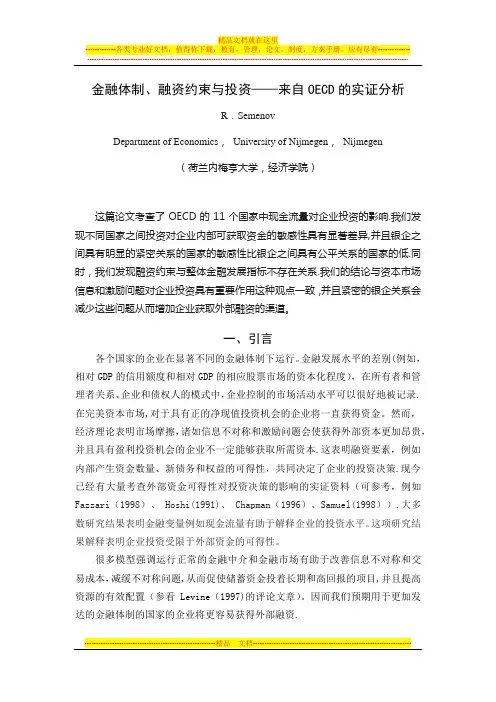
金融体制、融资约束与投资——来自OECD的实证分析R.SemenovDepartment of Economics,University of Nijmegen,Nijmegen(荷兰内梅亨大学,经济学院)这篇论文考查了OECD的11个国家中现金流量对企业投资的影响.我们发现不同国家之间投资对企业内部可获取资金的敏感性具有显著差异,并且银企之间具有明显的紧密关系的国家的敏感性比银企之间具有公平关系的国家的低.同时,我们发现融资约束与整体金融发展指标不存在关系.我们的结论与资本市场信息和激励问题对企业投资具有重要作用这种观点一致,并且紧密的银企关系会减少这些问题从而增加企业获取外部融资的渠道。
一、引言各个国家的企业在显著不同的金融体制下运行。
金融发展水平的差别(例如,相对GDP的信用额度和相对GDP的相应股票市场的资本化程度),在所有者和管理者关系、企业和债权人的模式中,企业控制的市场活动水平可以很好地被记录.在完美资本市场,对于具有正的净现值投资机会的企业将一直获得资金。
然而,经济理论表明市场摩擦,诸如信息不对称和激励问题会使获得外部资本更加昂贵,并且具有盈利投资机会的企业不一定能够获取所需资本.这表明融资要素,例如内部产生资金数量、新债务和权益的可得性,共同决定了企业的投资决策.现今已经有大量考查外部资金可得性对投资决策的影响的实证资料(可参考,例如Fazzari(1998)、 Hoshi(1991)、 Chapman(1996)、Samuel(1998)).大多数研究结果表明金融变量例如现金流量有助于解释企业的投资水平。
这项研究结果解释表明企业投资受限于外部资金的可得性。
很多模型强调运行正常的金融中介和金融市场有助于改善信息不对称和交易成本,减缓不对称问题,从而促使储蓄资金投着长期和高回报的项目,并且提高资源的有效配置(参看Levine(1997)的评论文章)。
因而我们预期用于更加发达的金融体制的国家的企业将更容易获得外部融资.几位学者已经指出建立企业和金融中介机构可进一步缓解金融市场摩擦。
毕业设计外文翻译译文
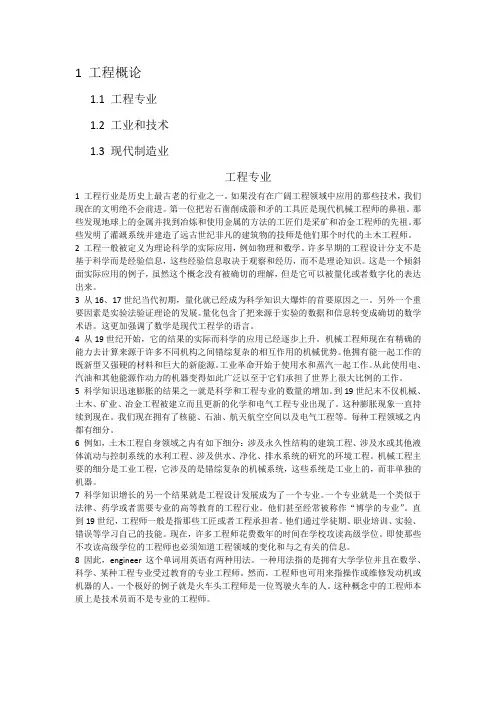
1 工程概论1.1 工程专业1.2 工业和技术1.3 现代制造业工程专业1 工程行业是历史上最古老的行业之一。
如果没有在广阔工程领域中应用的那些技术,我们现在的文明绝不会前进。
第一位把岩石凿削成箭和矛的工具匠是现代机械工程师的鼻祖。
那些发现地球上的金属并找到冶炼和使用金属的方法的工匠们是采矿和冶金工程师的先祖。
那些发明了灌溉系统并建造了远古世纪非凡的建筑物的技师是他们那个时代的土木工程师。
2 工程一般被定义为理论科学的实际应用,例如物理和数学。
许多早期的工程设计分支不是基于科学而是经验信息,这些经验信息取决于观察和经历,而不是理论知识。
这是一个倾斜面实际应用的例子,虽然这个概念没有被确切的理解,但是它可以被量化或者数字化的表达出来。
3 从16、17世纪当代初期,量化就已经成为科学知识大爆炸的首要原因之一。
另外一个重要因素是实验法验证理论的发展。
量化包含了把来源于实验的数据和信息转变成确切的数学术语。
这更加强调了数学是现代工程学的语言。
4 从19世纪开始,它的结果的实际而科学的应用已经逐步上升。
机械工程师现在有精确的能力去计算来源于许多不同机构之间错综复杂的相互作用的机械优势。
他拥有能一起工作的既新型又强硬的材料和巨大的新能源。
工业革命开始于使用水和蒸汽一起工作。
从此使用电、汽油和其他能源作动力的机器变得如此广泛以至于它们承担了世界上很大比例的工作。
5 科学知识迅速膨胀的结果之一就是科学和工程专业的数量的增加。
到19世纪末不仅机械、土木、矿业、冶金工程被建立而且更新的化学和电气工程专业出现了。
这种膨胀现象一直持续到现在。
我们现在拥有了核能、石油、航天航空空间以及电气工程等。
每种工程领域之内都有细分。
6 例如,土木工程自身领域之内有如下细分:涉及永久性结构的建筑工程、涉及水或其他液体流动与控制系统的水利工程、涉及供水、净化、排水系统的研究的环境工程。
机械工程主要的细分是工业工程,它涉及的是错综复杂的机械系统,这些系统是工业上的,而非单独的机器。
本科毕业设计外文翻译(中文)
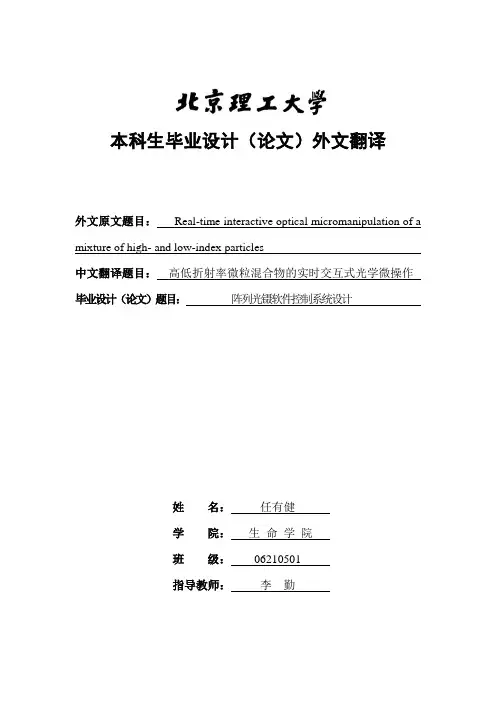
本科生毕业设计(论文)外文翻译外文原文题目:Real-time interactive optical micromanipulation of a mixture of high- and low-index particles中文翻译题目:高低折射率微粒混合物的实时交互式光学微操作毕业设计(论文)题目:阵列光镊软件控制系统设计姓名:任有健学院:生命学院班级:06210501指导教师:李勤高低折射率微粒混合物的实时交互式光学微操作Peter John Rodrigo Vincent Ricardo Daria Jesper Glückstad丹麦罗斯基勒DK-4000号,Risø国家实验室光学和等离子研究系jesper.gluckstad@risoe.dkhttp://www.risoe.dk/ofd/competence/ppo.htm摘要:本文论证一种对于胶体的实时交互式光学微操作的方法,胶体中包含两种折射率的微粒,与悬浮介质(0n )相比,分别低于(0L n n <)、高于(0H n n >)悬浮介质的折射率。
球形的高低折射率微粒在横平板上被一批捕获激光束生成的约束光势能捕获,捕获激光束的横剖面可以分为“礼帽形”和“圆环形”两种光强剖面。
这种应用方法在光学捕获的空间分布和个体几何学方面提供了广泛的可重构性。
我们以实验为基础证实了同时捕获又独立操作悬浮于水(0 1.33n =)中不同尺寸的球形碳酸钠微壳( 1.2L n ≈)和聚苯乙烯微珠( 1.57H n =)的独特性质。
©2004 美国光学学会光学分类与标引体系编码:(140.7010)捕获、(170.4520)光学限制与操作和(230.6120)空间光调制器。
1 引言光带有动量和角动量。
伴随于光与物质相互作用的动量转移为我们提供了在介观量级捕获和操作微粒的方法。
过去数十年中的巨大发展已经导致了在生物和物理领域常规光学捕获的各种应用以及下一代光学微操作体系的出现[1-5]。
隧道盾构-毕设论文外文翻译(翻译-原文)
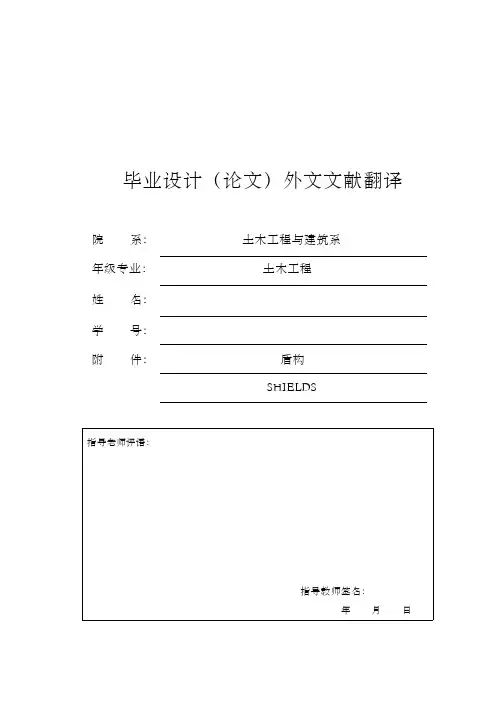
毕业设计(论文)外文文献翻译院系:土木工程与建筑系年级专业:土木工程姓名:学号:附件:盾构SHIELDS指导老师评语:指导教师签名:年月日S HIEL D S【Abstr act】A tunnel shield is a structural system, used during the face excavation process. The paper mainly discusses the form and the structure of the shield. Propulsion for the shield is provided by a series of hydraulic jacks installed in the tail of the shield and the shield is widespread used in the underground environment where can not be in long time stable. The main enemy of the shield is ground pressure. Non-uniform ground pressure caused by the steering may act on the skin tends to force the shield off line and grade. And working decks inside the shield enable the miners to excavate the face, drill and load holes.【Keywor ds】shield hydraulic jacks ground pressure steering working decksA tunnel shield is a structural system, normally constructed of steel, used during the face excavation process. The shield has an outside configuration which matches the tunnel. The shield provides protection for the men and equipment and also furnished initial ground support until structural supports can be installed within the tail section of the shield. The shield also provides a reaction base for the breast-board system used to control face movement. The shield may have either an open or closed bottom. In a closed-bottom shield, the shield structure and skin provide 360-degree ground contact and the weight of the shield rests upon the invert section of the shield skin. The open shield has no bottom section and requires some additional provision is a pair of side drifts driven in advance of shield excavation. Rails or skid tracks are installed within these side drifts to provide bearing support for the shield.Shield length generally varies from1/2 to 3/4 of the tunnel diameter. The front of the shield is generally hooded to so that the top of the shield protrudes forward further than the invert portion which provides additional protection for the men working at the face and also ease pressure on the breast-boards. The steel skin of the shield may varyfrom 1.3 to 10 cm in thickness, depending on the expected ground pressures. The type of steel used in the shield is the subject of many arguments within the tunneling fraternity. Some prefer mild steel in the A36 category because of its ductility and case of welding in the underground environment where precision work is difficult. Others prefer a high-strength steel such as T-1 because of its higher strength/w eight ratio. Shield weight may range from 5 to 500 tons. Most of the heaviest shields are found in the former Sovier Union because of their preference for cast-iron in both structural and skin elements.Propulsion for the shield is provided by a series of hydraulic jacks installed in the tail of the shield that thrust against the last steel set that has been installed. The total required thrust will vary with skin area and ground pressure. Several shields have been constructed with total thrust capabilities in excess of 10000 tons. Hydraulic systems are usually self-contained, air-motor powered, and mounted on the shield. Working pressures in the hydraulic system may range from 20-70 Mpa. To resist the thrust of the shield jacks, a horizontal structure member (collar brace) must be installed opposite each jack location and between the flanges of the steel set. In addition, some structural provision must be made for transferring this thrust load into the tunnel walls. Without this provision the thrust will extend through the collar braces to the tunnel portal.An Englishman, Marc Brunel, is credited with inventing the shield. Brunel supposedly got his idea by studying the action of the Teredo navalis, a highly destructive woodworm, when he was working at the Chatham dock yard. In 1818 Brunel obtained an English patent for his rectangular shield which was subsequently uses to construct the first tunnel under the River Thames in London. In 1869 the first circular shield was devised by Barlow and Great Head in London and is referred to as the Great Head-type shield. Later that same year, Beach in New York City produced similar shield. The first use of the circular shield came during 1869 when Barlow and Great Head employed their device in the construction of the 2.1 in diameter Tower Subway under the River Thames. Despite the name of the tunnel, it was used only for pedestrian traffic. Beach also put his circular shield to work in 1869 to construct a demonstration project for a proposed NewYork City subway system. The project consisted of a 2.4 m diameter tunnel, 90 m long, used to experiment with a subway car propelled by air pressure.Here are some tunnels which were built by shield principle.Soft-ground tunneling Some tunnels are driven wholly or mostly through soft material. In very soft ground, little or no blasting is necessary because the material is easily excavated.At first, forepoling was the only method for building tunnels through very soft ground. Forepoles are heavy planks about 1.5 m long and sharpened to a point. They were inserted over the top horizontal bar of the bracing at the face of the tunnel. The forepoles were driven into the ground of the face with an outward inclination. After all the roof poles were driven for about half of their length, a timber was laid across their exposed ends to counter any strain on the outer ends. The forepoles thus provided an extension of the tunnel support, and the face was extended under them. When the ends of the forepoles were reached, new timbering support was added, and the forepoles were driven into the ground for the next advance of the tunneling.The use of compressed air simplified working in soft ground. An airlock was built, though which men and equipment passed, and sufficient air pressure was maintained at the tunnel face to hold the ground firm during excavation until timbering or other support was erected.Another development was the use of hydraulically powered shields behind which cast-iron or steel plates were placed on the circumference of the tunnels. These plates provided sufficient support for the tunnel while the work proceeded, as well as full working space for men in the tunnel.Under water tunneling The most difficult tunneling is that undertaken at considerable depths below a river or other body of water. In such cases, water seeps through porous material or crevices, subjecting the work in progress to the pressure of the water above the tunneling path. When the tunnel is driven through stiff clay, the flow of water may be small enough to be removed by pumping. In more porous ground,compressed air must be used to exclude water. The amount of air pressure that is needed increases as the depth of the tunnel increases below the surface.A circular shield has proved to be most efficient in resisting the pressure of soft ground, so most shield-driven tunnels are circular. The shield once consisted of steel plates and angle supports, with a heavily braced diaphragm across its face. The diaphragm had a number of openings with doors so that workers could excavate material in front of the shield. In a further development, the shield was shoved forward into the silty material of a riverbed, thereby squeezing displaced material through the doors and into the tunnel, from which the muck was removed. The cylindrical shell of the shield may extend several feet in front of the diaphragm to provide a cutting edge. A rear section, called the tail, extends for several feet behind the body of the shield to protect workers. In large shields, an erector arm is used in the rear side of the shield to place the metal support segments along the circumference of the tunnel.The pressure against the forward motion of a shield may exceed 48.8 Mpa. Hydraulic jacks are used to overcome this pressure and advance the shield, producing a pressure of about 245 Mpa on the outside surface of the shield.Shields can be steered by varying the thrust of the jacks from left side to right side or from top to bottom, thus varying the tunnel direction left or right or up or down. The jacks shove against the tunnel lining for each forward shove. The cycle of operation is forward shove, line, muck, and then another forward shove. The shield used about 1955 on the third tube of the Lincoln Tunnel in New York City was 5.5 m long and 9.6 m in diameter. It was moved about 81.2 cm per shove, permitting the fabrication of a 81.2 cm support ring behind it.Cast-iron segments commonly are used in working behind such a shield. They are erected and bolted together in a short time to provide strength and water tightness. In the third tube of the Lincoln Tunnel each segment is 2 m long, 81.2 cm wide, and 35.5 cm thick, and weighs about 1.5 tons. These sections form a ring of 14 segments that are linked together by bolts. The bolts were tightened by hand and then by machine.Immediately after they were in place, the sections were sealed at the joints to ensure permanent water tightness.Shields are most commonly used in ground condition where adequate stand-up time does not exist. The advantage of the shield in this type of ground, in addition to the protection afforded men and equipment , is the time available to install steel ribs, liner plates, or precast concrete segments under the tail segment of the shield before ground pressure and movement become adverse factors.One of the principle problems associated with shield use is steering. Non-uniform ground pressure acting on the skin tends to force the shield off line and grade. This problem is particularly acute with closed bottom shield that do not ride on rails or skid tracks. Steering is accomplished by varying the hydraulic pressure in individual thrust jacks. If the shied is trying to dive, additional pressure on the invert jacks will resist this tendency. It is not unusual to find shield wandering several feet from the required. Although lasers are frequently used to provide continuous line and grade data to operator, once the shield wanders off its course, its sheer bulk resists efforts to bring it back. Heterogeneous ground conditions, such as clay with random boulders, also presents steering problems.One theoretical disadvantage of the shield is the annular space left between the support system and the ground surface. When the support system is installed within the tail section of the shield, the individual support members are separated from the ground surface by the thickness of the tail skin. When steel ribs are used, the annular space is filled with timber blocking as the forward motion of the shield exposes the individual ribs.A continuous support system presents a different problem. In this case, a filler material, such as pea gravel or grout, is pumped behind the support system to fill the void between it and the ground surface.The main enemy of the shield is ground pressure. As ground pressure begins to build, two things happen, more thrust is required for shield propulsion and stress increases in the structural members of the shield. Shields are designed and function undera preselected ground pressure. Designers will select this pressure as a percentage of the maximum ground pressure contemplated by the permanent tunnel design. In some cases, unfortunately, the shield just gets built without specific consideration of the ground pressures it might encounter. When ground pressure exceeds the design limit, the shield gets “stuck”.The friction component of the ground pressure on the skin becomes greater than the thrust capability of the jacks. Several methods, including pumping bentonite slurry into the skin, ground interface, pushing heavy equipment, and bumping with dynamite, have been applied to stuck shields with occasional success.Because ground pressure tends to increase with time, the cardinal rule of operation is “keeping moving”.This accounts for the fracture activity when a shield has suffered a temporary mechanical failure. As ground pressure continues to build on the nonmoving shield , the load finally exceeds its structural limit and bucking begins. An example of shield destruction occurred in California in 1968 when two shields being used to drive the Carly V.Porter Tunnel were caught by excessive ground pressure and deformed beyond repair. One of the Porter Tunnel shields was brought to a halt in reasonably good ground by water bearing ground fault that required full breast-boards. While the contractor was trying to bring the face under control, skin pressure began to increase. While the face condition finally stabilized, the contractor prepared to resume operations and discovered the shield was stuck. No combination of methods was able to move it, and the increasing ground pressure destroyed the shield.To offset the ground pressure effect, a standard provision in design is a cutting edge radius several inches greater than the main body radius. This allows a certain degree o f ground movement before pressure can come to bear on the shield skin. Another approach, considered in theory but not yet put into practice, is the “w atermelon seed”design. The theory calls for a continuous taper in the shield configuration; maximum radius at the cutting edge and the minimum radius at the trailing edge of the tail. With this configuration, any amount of forward movement would create a drop in skin pressure.Working decks, spaced 2.4 to 3.0 m vertically, are provided inside the shield. These working decks enable the miners to excavate the face, drill and load holes, if necessary, and adjust the breast-board system. The hydraulic jacks for the breast-board are mounted on the underside of the work decks. Blast doors are sometimes installed as an integral part of the work decks if a substantial amount of blasting is expected.Some form of mechanical equipment is provided on the rear end of the working decks to assist the miners in handing and placing the element of the support system. In large tunnels, these individual support elements can weigh several tons and mechanical assistance becomes essential. Sufficient vertical clearance must be provided between the invert and the first working deck to permit access to the face by the loading equipment.盾构【摘要】隧道盾构是一结构系统,通常用于洞室开挖。
毕业设计中英文翻译
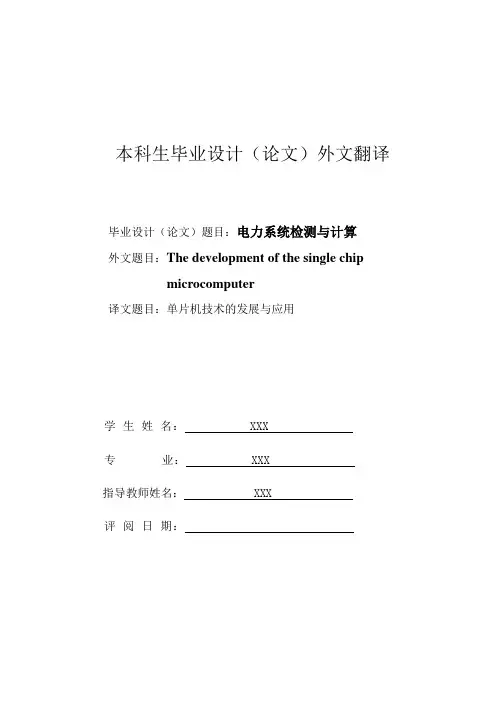
本科生毕业设计(论文)外文翻译毕业设计(论文)题目:电力系统检测与计算外文题目:The development of the single chipmicrocomputer译文题目:单片机技术的发展与应用学生姓名: XXX专业: XXX指导教师姓名: XXX评阅日期:单片机技术的发展与应用从无线电世界到单片机世界现代计算机技术的产业革命,将世界经济从资本经济带入到知识经济时代。
在电子世界领域,从 20 世纪中的无线电时代也进入到 21 世纪以计算机技术为中心的智能化现代电子系统时代。
现代电子系统的基本核心是嵌入式计算机系统(简称嵌入式系统),而单片机是最典型、最广泛、最普及的嵌入式系统。
一、无线电世界造就了几代英才。
在 20 世纪五六十年代,最具代表的先进的电子技术就是无线电技术,包括无线电广播,收音,无线通信(电报),业余无线电台,无线电定位,导航等遥测、遥控、遥信技术。
早期就是这些电子技术带领着许多青少年步入了奇妙的电子世界,无线电技术展示了当时科技生活美妙的前景。
电子科学开始形成了一门新兴学科。
无线电电子学,无线通信开始了电子世界的历程。
无线电技术不仅成为了当时先进科学技术的代表,而且从普及到专业的科学领域,吸引了广大青少年,并使他们从中找到了无穷的乐趣。
从床头的矿石收音机到超外差收音机;从无线电发报到业余无线电台;从电话,电铃到无线电操纵模型。
无线电技术成为当时青少年科普、科技教育最普及,最广泛的内容。
至今,许多老一辈的工程师、专家、教授当年都是无线电爱好者。
无线电技术的无穷乐趣,无线电技术的全面训练,从电子学基本原理,电子元器件基础到无线电遥控、遥测、遥信电子系统制作,培养出了几代科技英才。
二、从无线电时代到电子技术普及时代。
早期的无线电技术推动了电子技术的发展,其中最主要的是真空管电子技术向半导体电子技术的发展。
半导体电子技术使有源器件实现了微小型化和低成本,使无线电技术有了更大普及和创新,并大大地开阔了许多非无线电的控制领域。
论文中英文翻译(译文)
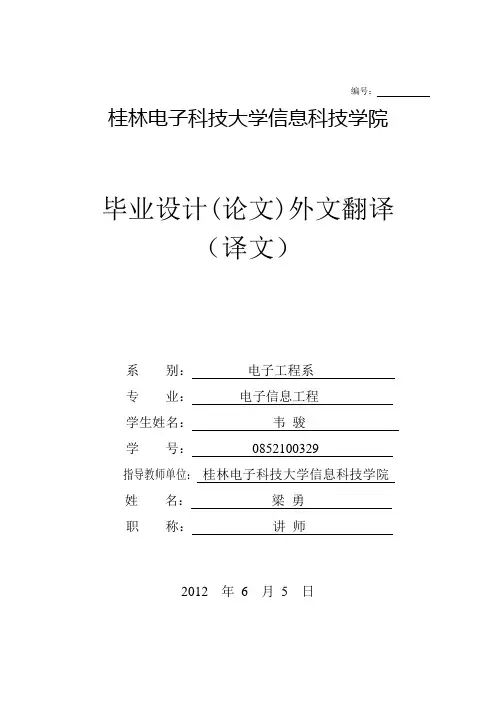
编号:桂林电子科技大学信息科技学院毕业设计(论文)外文翻译(译文)系别:电子工程系专业:电子信息工程学生姓名:韦骏学号:0852100329指导教师单位:桂林电子科技大学信息科技学院姓名:梁勇职称:讲师2012 年6 月5 日设计与实现基于Modbus 协议的嵌入式Linux 系统摘要:随着嵌入式计算机技术的飞速发展,新一代工业自动化数据采集和监测系统,采用核心的高性能嵌入式微处理器的,该系统很好地适应应用程序。
它符合消费等的严格要求的功能,如可靠性,成本,尺寸和功耗等。
在工业自动化应用系统,Modbus 通信协议的工业标准,广泛应用于大规模的工业设备系统,包括DCS,可编程控制器,RTU 及智能仪表等。
为了达到嵌入式数据监测的工业自动化应用软件的需求,本文设计了嵌入式数据采集监测平台下基于Modbus 协议的Linux 环境采集系统。
串行端口的Modbus 协议是实现主/从式,其中包括两种通信模式:ASCII 和RTU。
因此,各种药膏协议的设备能够满足串行的Modbus通信。
在Modbus 协议的嵌入式平台实现稳定和可靠。
它在嵌入式数据监测自动化应用系统的新收购的前景良好。
关键词:嵌入式系统,嵌入式Linux,Modbus 协议,数据采集,监测和控制。
1、绪论Modbus 是一种通讯协议,是一种由莫迪康公司推广。
它广泛应用于工业自动化,已成为实际的工业标准。
该控制装置或不同厂家的测量仪器可以链接到一个行业监控网络使用Modbus 协议。
Modbus 通信协议可以作为大量的工业设备的通讯标准,包括PLC,DCS 系统,RTU 的,聪明的智能仪表。
随着嵌入式计算机技术的飞速发展,嵌入式数据采集监测系统,使用了高性能的嵌入式微处理器为核心,是一个重要的发展方向。
在环境鉴于嵌入式Linux 的嵌入式工业自动化应用的数据,一个Modbus 主协议下的采集监测系统的设计和实现了这个文件。
因此,通信设备,各种药膏协议能够满足串行的Modbus。
毕业设计(论文)外文资料翻译(学生用)
毕业设计外文资料翻译学院:信息科学与工程学院专业:软件工程姓名: XXXXX学号: XXXXXXXXX外文出处: Think In Java (用外文写)附件: 1.外文资料翻译译文;2.外文原文。
附件1:外文资料翻译译文网络编程历史上的网络编程都倾向于困难、复杂,而且极易出错。
程序员必须掌握与网络有关的大量细节,有时甚至要对硬件有深刻的认识。
一般地,我们需要理解连网协议中不同的“层”(Layer)。
而且对于每个连网库,一般都包含了数量众多的函数,分别涉及信息块的连接、打包和拆包;这些块的来回运输;以及握手等等。
这是一项令人痛苦的工作。
但是,连网本身的概念并不是很难。
我们想获得位于其他地方某台机器上的信息,并把它们移到这儿;或者相反。
这与读写文件非常相似,只是文件存在于远程机器上,而且远程机器有权决定如何处理我们请求或者发送的数据。
Java最出色的一个地方就是它的“无痛苦连网”概念。
有关连网的基层细节已被尽可能地提取出去,并隐藏在JVM以及Java的本机安装系统里进行控制。
我们使用的编程模型是一个文件的模型;事实上,网络连接(一个“套接字”)已被封装到系统对象里,所以可象对其他数据流那样采用同样的方法调用。
除此以外,在我们处理另一个连网问题——同时控制多个网络连接——的时候,Java内建的多线程机制也是十分方便的。
本章将用一系列易懂的例子解释Java的连网支持。
15.1 机器的标识当然,为了分辨来自别处的一台机器,以及为了保证自己连接的是希望的那台机器,必须有一种机制能独一无二地标识出网络内的每台机器。
早期网络只解决了如何在本地网络环境中为机器提供唯一的名字。
但Java面向的是整个因特网,这要求用一种机制对来自世界各地的机器进行标识。
为达到这个目的,我们采用了IP(互联网地址)的概念。
IP以两种形式存在着:(1) 大家最熟悉的DNS(域名服务)形式。
我自己的域名是。
所以假定我在自己的域内有一台名为Opus的计算机,它的域名就可以是。
本科毕业设计(论文)外文翻译
重金属污染存在于很多工业的废水中,如电镀,采矿,和制革。
2.实验
2.1化学药剂
本实验所使用的药剂均为分析纯,如无特别说明均购买自日本片山化工。铅离子储备液通过溶解Pb(NO3)2配制,使用时稀释到需要的浓度。HEPES缓冲液购买自Sigma–Aldrich。5 mol/L的HCl和NaOH用来调整pH。
附5
华南理工大学
本科毕业设计(论文)翻译
班级2011环境工程一班
姓名陈光耀
学号201130720022
指导教师韦朝海
填表日期
中文译名
(1)巯基改性纤维素对葡萄糖溶液中铅的吸附(2)黄原酸化橘子皮应用于吸附水中的铅离子
外文原文名
(1)Adsorption of Pb(II) from glucose solution on thiol-functionalized cellulosic biomass
2.5分析方法
铅离子的浓度用分光光度计在616 nm波长处用铅与偶氮氯膦-III络合物进行分析。葡萄糖含量采用苯酚—硫酸分光光度法测定。所有的实验均进行三次,已经考虑好误差。
3.结果和讨论
3.1FTIR分析和改性脱脂棉对铅(II)的吸附机制
图1是脱脂棉、改性脱脂棉在400-4000 cm-1(A)和2540-2560 cm-1(B)范围内的红外光谱图。可以看出,改性后改性脱脂棉的红外光谱图中在1735.71 cm-1处出现了一个新的吸收峰是酯基C=O的拉伸振动峰,可见改性脱脂棉中已经成功引入巯基官能团。同时,在2550.52 cm-1出现的一个新吸收峰代表的是S-H官能团的弱吸收峰,更深一层的证明了巯基已经嫁接到脱脂棉上。图1(b)是2540-2560 cm-1光谱范围的一个放大图像,可以清楚的观察到S-H官能团的弱吸收峰。进一步证明了酯化改性脱脂棉引入巯基是成功的。而从吸附后的曲线可以看到,2550.52cm-1处S-H的吸收峰消失,证明了硫原子和Pb(II)络合物的形成,同时1735.71cm-1处C=O的吸收峰强度看起来有轻微的减弱可能也是和Pb(II)的络合吸附有关。
毕业设计(论文)外文资料翻译【范本模板】
南京理工大学紫金学院毕业设计(论文)外文资料翻译系:机械系专业:车辆工程专业姓名:宋磊春学号:070102234外文出处:EDU_E_CAT_VBA_FF_V5R9(用外文写)附件:1。
外文资料翻译译文;2.外文原文.附件1:外文资料翻译译文CATIA V5 的自动化CATIA V5的自动化和脚本:在NT 和Unix上:脚本允许你用宏指令以非常简单的方式计划CATIA。
CATIA 使用在MS –VBScript中(V5.x中在NT和UNIX3。
0 )的共用部分来使得在两个平台上运行相同的宏。
在NT 平台上:自动化允许CATIA像Word/Excel或者Visual Basic程序那样与其他外用分享目标。
ATIA 能使用Word/Excel对象就像Word/Excel能使用CATIA 对象。
在Unix 平台上:CATIA将来的版本将允许从Java分享它的对象。
这将提供在Unix 和NT 之间的一个完美兼容。
CATIA V5 自动化:介绍(仅限NT)自动化允许在几个进程之间的联系:CATIA V5 在NT 上:接口COM:Visual Basic 脚本(对宏来说),Visual Basic 为应用(适合前:Word/Excel ),Visual Basic。
COM(零部件目标模型)是“微软“标准于几个应用程序之间的共享对象。
Automation 是一种“微软“技术,它使用一种解释环境中的COM对象。
ActiveX 组成部分是“微软“标准于几个应用程序之间的共享对象,即使在解释环境里。
OLE(对象的链接与嵌入)意思是资料可以在一个其他应用OLE的资料里连结并且可以被编辑的方法(在适当的位置编辑).在VBScript,VBA和Visual Basic之间的差别:Visual Basic(VB)是全部的版本。
它能产生独立的计划,它也能建立ActiveX 和服务器。
它可以被编辑。
VB中提供了一个补充文件名为“在线丛书“(VB的5。
毕业设计外文翻译
南京理工大学毕业设计(论文)外文资料翻译学院(系):电子工程与光电技术学院专业:电子科学与技术姓名:高航学号: 0704240113外文出处: ZTE COMMUNICATIONS 2009, 7 (4)(用外文写)附件: 1.外文资料译文;2.外文原文。
附件1:外文资料翻译译文一种用于移动终端视频图像色彩增强的实时方法作者:金辉摘要:智能手机在可视通话的过程中,由于摄像头和液晶显示器等硬件性能上的一些局限性,使其在某些条件或环境下采集的视频图像光线昏暗,或者视频图像表现的颜色不够鲜艳、靓丽甚至发生偏色。
文章提出一种在硬件具体的特性和性能参数下,对视频图像的明亮可视度以及颜色进行增强的实时方法。
在智能手机上的应用和验证显示,该方法不需要额外的芯片就能够改善移动可视电话中视频图像的主观视觉效果,提高亮度、清晰度,并使颜色的表现更丰富、艳丽。
关键字:移动可视终端;色彩增强;明亮可视度增强目前,对于移动智能手机来讲,传统的话音业务已经无法满足广大消费者个性化、差异化需求,所以各项增值业务被视为新的黄金增长点。
移动可视电话作为3G的标志性核心业务,逐渐受到各方的广泛关注。
视频通话过程中视频图像的质量直接影响到业务的普及与扩展,将来也会在市场上掀起一场完美的视频应用风暴。
在对TD-SCDMA的3G终端性能测试中,视频通话是测试的关键环节之一。
大部分3G手机终端视频通话质量都有不尽如人意的地方,如延迟、拖影、马赛克等现象。
这些主要是由于网络原因造成的视频质量问题。
除此之外还有视频图像本身的质量问题,如在暗的环境下,采集的图像昏暗不清,打可视电话时色彩不够丰富亮丽等。
这些问题已受到各通信设备供应商和技术研究者的关注。
在视频处理领域中,主观视觉质量的改善是视频增强的一个主要内容。
在消费电子领域中,视频增强技术令产品对于消费者更具有吸引力和魅力。
如今许多厂商都需要拥有自主的色彩增强技术,“颜色再现增强技术”已成为一个重要的话题。
- 1、下载文档前请自行甄别文档内容的完整性,平台不提供额外的编辑、内容补充、找答案等附加服务。
- 2、"仅部分预览"的文档,不可在线预览部分如存在完整性等问题,可反馈申请退款(可完整预览的文档不适用该条件!)。
- 3、如文档侵犯您的权益,请联系客服反馈,我们会尽快为您处理(人工客服工作时间:9:00-18:30)。
编号:桂林电子科技大学信息科技学院毕业设计(论文)外文翻译(译文)系(部):机电工程系专业:机械设计制造及自动化学生姓名:李汉显学号:1153100506指导教师单位:桂林航天工业学院姓名:陈志职称:讲师2015年5 月28日无损检测技术在检测石油管道时的可靠性卡瓦略·库切答(a);雷贝洛(b);米纳拉辛苏扎·苏哲(b);湖奈保尔·苏格瑞勒(c);萨拉•迪基·苏亚雷斯(d)a、华盛顿苏亚雷斯马路大学科学技术中心,1321;巴西福塔雷萨行政长官,埃德森奎罗兹临时选举委员会:60,811 -905b、巴西里约热内卢联邦大学临时选举委员会:21941 - 972c、巴西里约热内卢联邦大学土木工程系d、巴西里约热内卢大学城临时选举委员会:21949 - 900文章内容文章背景:2006年11月9日收到2008年5月21日修改后的表格2008年5月27日认可关键词:无损检测;可靠性;超声检测;X线摄影摘要这项工作的目的是评估无损检测技术(NDT)在检查石油工业中的管道焊缝的可靠性。
X射线,手动和全自动的超声波都利用了脉冲回波和光线干涉原理。
三个层面的缺陷分析为:缺乏渗透(LP),缺乏融合(LF)和削弱(UC)。
这些测试是对含焊缝缺陷已被人为地确定为标本的管道进行测试。
结果表明:全自动超声波检测缺陷与手动超声波、X光测试相比更具有优越性。
此外,人工神经网络已被用于探测缺陷和缺陷的自动分类。
1简介在长距离的流体(包括石油和天然气)传输过程中,管道运输时最安全最经济的方法。
由于这一点和管道的效率,他们已用了几十年。
但是由于种种因素,如腐蚀,疲劳,甚至侵蚀所增加泄漏的危险,甚至破裂,这些都是现在应该考虑的关键问题。
还应该指出,许多管道铺设在接近道路,铁路,水路甚至在城市或在其下方。
因此,必须有方法监测,评价和肯定管道的完整性,减少泄漏的风险,从而避免环境破坏和人群危害。
多年来,无损检测在石油管道的状态检测中显示了其高效性。
无损检测技术正被研究的越来越深,同时已经作为评估工程结构、工程系统使用寿命的方法。
这项研究特别注意了石油工业可能发生的设备故障导致严重后果,比如环境污染和人员伤亡。
然而,一般认为应考虑采取最适当的参数来选择无损技术,剩下的就是它的使用可靠性,其中一个检测与确定缺陷大小的评估检测概率曲线(POD)是最具代表性的。
对于管道检测的两种技术超声波和X线检查比传统方法更具有出色的效率和易于操作性。
无论是手动超声波或常规和自动超声波都经常使用,虽然自动方法有多种优势。
这些优点是检测速度快,检测概率的增加,从而增加检查的可靠性,检测数据记录,结果的图像处理和人工神经网络计算机处理]31[ ,等等。
虽然放射检测仍然普遍用于检查石油工业用管道,但已经正在努力向能够代替它的方法发展,这主要是由于它们有如下不便:电离辐射对操作者的威胁、进一步研究影像的保持问题。
图像处理技术,信号处理和人工神经网络的完美集合为无损检测技术一般的评价可靠性做出了重要的贡献,可作为现场的工作情况的记载辅助工具。
这个工作的目的在于评估探测管线系统的可靠性。
四个不同的技术被应用上:手动超声波、全自动脉波-回波超声波、全自动TOFD超声波以及摄影。
图1 测试图解此外,人工神经网络方法应用于选择和分类缺陷形式。
最初的神经网络自动分类技术进行评估的的结果是缺陷(D)和无缺陷(ND)。
在以后的神经网络自动测试分为三类缺陷:缺乏渗透(LP)、缺乏融合(LF)和削弱(UC)。
信号处理工具是用来改善分类的绩效。
管道在焊缝过程中被人为制造了缺陷,进行了三个层次的缺陷模拟:缺乏渗透(LP)、缺乏融合(LF)和削弱(UC)。
在过去的几年,一些研究者已经开发出了无损检测可靠性评估。
在最近的报导中,甘多斯应用贝叶斯]54[、模型的不确定性,更新了在循环检测测量裂纹深度。
这个应用程序检测缺陷深度采用的是超声脉波-回波(纵向和横波) 技术,聚焦探头、相控线阵和时间衍射的有限元分析。
在另一篇当中,甘多斯]6[提出的一个框架为量化ENIQ(欧洲网络进行检查资格)检验合格的方法论,采用贝叶斯机制,甘多斯]6[表明它将是证明聚集技术的资料和证据。
2评估方法2.1试样为了进行试验,标本是从直径为254毫米,厚19毫米,长6000毫米的APIX70管道制取的。
12个环焊缝缺陷被人为地插入了焊缝(图1),同时两处无缺陷,也焊接了14焊缝。
插入的三类缺陷是:缺乏融合,缺乏渗透,削弱(图2)。
一共有8个缺陷沿每个放入的12焊珠。
所有的焊缝进程都使用两种不同的进程:氩弧焊根通、气体保护焊条焊接或药芯焊丝电弧焊满缝隙。
焊接后的标本按如下顺序检查:X光技术、人工超声波检测和全自动超声波检测。
缺陷融合的模拟使用了与预期大小相同缺陷薄片状与以前侧壁对锥焊接。
图3缺陷和缺乏融合模拟图显示的高度已经降低约2毫米,以确认它的存在,在一个缺陷融合模拟区金相部分。
缺陷渗透模拟也是利用薄板焊接根置于此缺陷的预计高度。
所有的缺陷检测在20至30毫米长度上,在32个缺陷位置每一层次的缺陷造成四个不同的高度(1,2,4和8毫米)。
表1显示了每个缺陷的高度和沿关节的变化。
2.2使用X光测试的试样检查X线检查用的是伽马射线(来源:钴60)和X射线。
两种检查方法被用于:双壁单形像和单壁单图像。
测试焊接接头使用伽玛四拍造影,而使用X光检查每个关节采用的是八拍。
为了帮助在胶片上的缺陷识别和大小判定进行可视化,相同的是数字化和加工使用特定的数字滤波器,消除和平滑的任何最终的X光图像的噪声。
要重点指出的是,为了不失去任何图像过滤器程序应进行仔细的扫描,例如可能产生的缺陷偏小的现象。
图2三个焊缝类型缺陷的素描研究:(a)融合缺乏,(b)缺乏渗透和(c)削弱2.3使用超声波测试的试样检查为了进行可靠性标本检查三个合格的检查者进行操作人工回波检测缺陷长度,。
对这个尺寸长度的缺陷按照6分贝的方法和标准进行验收,使用的是距离幅度曲线(DAC)。
校准曲线的工作是由一个参考块,详细的检查过程中PR-011]87[、,每个检验员追踪自己的工作曲线进行了检测。
图3模拟缺乏融合的方法2.4用自动超声技术检查标本自动检测设备使用的磁轮车辆进行检查,这一设备是由一套固定的传感器负责沿线的扫描,由常规超声波焊接设备、8位超声波传感器换能信号、计算机控制系统和存储数据组成。
这个模拟输出信号的超声波设备被连接到计算机,通过转换并在数字扫面脉冲20ms/s下进行数字化。
这种转换器是负责超声检测信号数字化,将会被储存在电脑的记忆。
计算机是负责下列操作:控制、通过并行端口,任何的8位传感器的信号,它的输入是控制检查车辆运动的通过串口和储存的数字化的信号。
图4金相部分地区的焊缝缺陷。
箭头表示职位的缺陷对于TOFD检测技术的结果分析,是由一个特定开发的程序MATLAB软件来完成的,它的目的是为了读A扫描和装配一个D 扫描图像。
这个程序允许沿焊缝的连续性检测,测量周围的管道周长长度和厚度垂直高度。
校准后,所有发现的缺陷的大小可以确定的。
3结果最初,初步评价中的缺陷是由人为伽马线和几何学的单图像-双墙检测技术。
实验结果表明,未焊透和削弱引起的缺陷能够显示在放射性照片上,但缺乏融合的缺陷,尽管采用高分辨率细纹射线胶片用伽马和x射线,甚至当采用单一图像-单壁技术进行检查,也是无法检测出来的。
根据摩根]9[等关于缺乏融合缺陷由外侧壁插入斜面焊接,因此这是一个清晰明了的结果:这类故障不能利用影像学技术进行检测。
表1 角度和模拟缺陷投影高度图5显示了通过中位数过滤器和经过数字化的含有高度约8mm缺乏渗透的焊缝缺陷的X光影像。
图5 高8毫米(含)焊缝缺陷与不足的投影表2显示的是用人工和自动超声回波检测技术检测到的各个层次缺陷的数据。
此表表明,在检测过程中,缺乏渗透类缺陷概率至少为75%(2号检测结果),而检查结果1和3达到了90.6%的检测概率。
这类缺陷平均大小错误在28.6%和34%之间。
这些测试结果表明,随着缺陷高度的增加,POD的效率也随着提高;但需要指出的是,当使用6分贝超声检测方法时高度的增加和长度的正确大小两者之间没有直接关系。
实验结果对于削弱缺陷显示(表2):由1号和2号检测的概率分别是100%和96.9%。
结果中的87.5%是由3号检测机器人对高度减少1-2mm的削弱缺陷进行无损检测得到的。
尺寸误差的波动范围是21.1%到24.5%,但是随着高度的增加误差的概率而在增加,这与检测方法无关。
从放射检测中,这些尺寸误差决定了缺陷的真实尺寸的价值。
由于不可能使用射线技术来检测缺乏融合这一种缺陷,所以这类缺陷的误差将无法得到。
表2 缺陷等级评估技术的总结对于缺乏融合,缺损的误差概率在90.6%和96.9%之间变化,其效率随着缺陷高度的增加而趋于完善,与使用的焊接方法无关。
使用自动超声脉冲回波探测技术,其高概率将会显现出来。
在所有插入的缺陷(每类32个)中只有6个缺乏融合缺陷和2个削弱缺陷不能被检测到。
在评价自动脉冲回波技术检测中,应用了自己的信号A扫描,如图6所示。
图6 含有8个削弱缺陷的扫描信号在自动脉冲回波测试,各种传感器定位在一个装置,检测整个标本移到沿焊缝所有厚度,如图7所示。
这一试验表明,在检测小缺陷时,传感器之间的覆盖物是必要的。
图7 自动脉波-回波超声检查对缺陷的高度尺寸进行检测使用了自动超声波TOFD检测技术。
这项加载了自动脉冲回波技术的检测方法,具有误差很小的检测概率。
在所有样本中插入人工缺陷,TOFD 检测技术检测的融合缺陷达到93.75%,渗透缺陷达到53.13%和削弱类缺陷为100%。
在TOFD科技的自动检测缺陷中,缺陷的检测是由D扫描图像完成,而缺陷高度尺寸是由A扫描信号完成的。
图8 D扫描图像检测缺陷的TOFD技术表3显示的是缺乏渗透类缺陷在人工脉冲回拨检测中的结果,在这三种检测方法中尺寸的平均误差是30.7%,远低于由射线探测得到的数据。
它也表明,最大的误差发生在最大的缺陷尺寸处。
对于自动脉冲回波测试平均误差为18.9%,也倾向于低估的实际长度。
此外,不同于手动脉冲回波测试,最大误差出现在高度最小的缺陷。
对于在TOFD 检测技术的缺陷通过X光图像,检测到的长度尺寸平均误差只有12%,倾向于特大型长度。
但是可以证明,对于缺乏融合类缺陷的自动化技术的得到的误差大小比传统测试得到的要小。
表3 缺陷尺寸误差对比对于削弱类缺陷由人工超声回波得到的平均尺寸误差大小为22.4%,倾向于大于由射线测试得到的数据。
检测器得到结论是缺陷高度越大则误差也越大。
自动脉冲回波检测到的缺陷误差平均大小是26.2%也与实际尺寸偏大。
然而,通过射线测试TOFD技术得到的平均误差大小是112.2%又比实际尺寸偏大。
